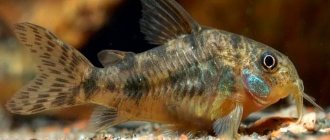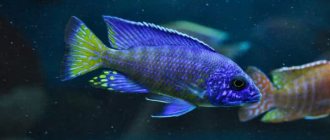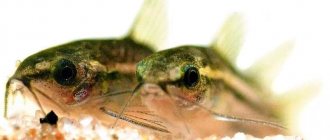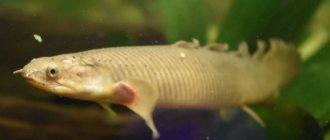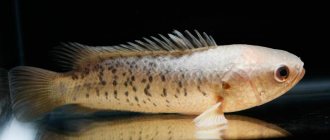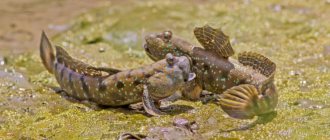Mollies are beautiful and unpretentious viviparous aquarium fish. It is popular among beginners and is interesting as a breedable species for professionals. It coexists well with a lot of other fish and is able to decorate any aquarium.
| Full name | Mollies/Poecilia |
| Kinds | Mollies sphenops, velifera, latipina, petenes, free-ranging, dwarf, golden, silver, marbled, balloons, lyretails |
| Color | Black, white, yellow, red, silver blue |
| Water | Volume per fish – 10 liters PH (acid-base balance) – 7-8 KH (hardness) – 10-20 t (temperature) – 25-28°C |
| Feed | Live food - bloodworms, tubifex, coretra, daphnia, gammarus and brine shrimp; frozen food of the same types; feeding from boiled and crushed eggs, meat, liver, sea fish; plant food - tablets and flakes with spirulina algae, blanched vegetables, dried herbs, crushed oatmeal and semolina; dry food, balanced in terms of vitamins, minerals and fiber - Tetrapro Algae, Tetra Phyll and Tetramin Flakes |
| Compatibility | Viviparous - gupeshki, swordtails, platies; labyrinthine - lalius, gourami; spawners with a calm character - zebrafish, thornets, angelfish, barbs |
| Priming | It doesn’t matter, for black species light is better |
| Plants | Fast-growing species with hard leaves - Vallisneria, hardleaf arrowhead, Java moss, Riccia, Elodea, water cabbage |
| Scenery | Shelters – driftwood, weathered rocks, grottoes or caves |
| Lifespan | They live in an aquarium for 3–5 years |
History of aquarium breeding
Mollies appeared in the aquarium hobby at the turn of the 19th and 20th centuries, and as a result of 20 years of breeding work, the first hybrid specimens were developed.
Now there are a lot of varieties of mollies, but only a few of them, for example, Velifera, are especially popular. A strange confusion arose with this breed; ichthyologists classified it as two species at once - Mollienesia and Poecilia, which is why it is sometimes called platie.
Mollies were discovered for the first time in America; later this species was introduced and distributed in the reservoirs of Colombia, Israel, Japan, Taiwan and Eastern Europe.
Degrees and liters
It is better to start calculating the volume of water for adult aquarium mollies from six liters. It's minimum. It is advisable to provide at least eight liters for high-finned forms. But of course, the more, the better. A flock of molly will feel great in a 200-liter aquatic tank.
The temperature range for keeping fish is from 22 to 30 degrees. Sudden temperature changes are extremely undesirable. This can happen when the aquarium is maintained at 30 degrees and one-third of the volume is replaced with cold water.
Description and habitat
Mollies are a heat-loving, viviparous fish of the Poeciliidae family of the ray-finned class with a lifespan of about 4 years. Its closest relative is the guppy.
The average size of aquarium specimens is about 6 cm, and in nature, males reach a length of 10 cm, females even 16 cm.
Wild varieties are gray-yellow in color with a silvery tint, with the back always darker than the belly. These are very peaceful, but unusually active underwater inhabitants.
There are three main types of mollies common in natural habitats:
- small-finned;
- broad-finned;
- sailing
Breeders have currently bred about 30 new breeds.
The native species are the Central and southern parts of North America; the sphenopis variety is also found in the reservoirs of Mexico and Colombia.
Today, after the spread of this species of fish throughout almost the entire globe, varieties of free and peten mollies live in the reservoirs of Guatemala and the eastern part of the United States of America. And sailing and velifer ones are on the island of Yucotan.
Photo gallery of mollies:
This fish prefers fresh water bodies, but can also live in slightly salty bays or on sea coasts, for example, in the lowlands of rivers flowing into the Atlantic Ocean. And the Latipinna species also lives in slightly saline lakes in the states of Virginia, Florida, Carolina, and Texas.
These fish settle in river mouths, lakes, ditches, and reservoirs of karst caves. They are usually omnivorous, although some species prefer worms and insects, while others feed almost exclusively on algae, such as latypal.
Molly habitat in natural conditions
If we are talking about snowflake, velifera, sphenops or latipine, then these are all representatives of the same species - mollies, although these closely related fish may have completely different external characteristics. But these fish have one thing in common - a set of qualities necessary for an ideal aquarium inhabitant. The homeland of mollies is North and South America; these fish mainly live in coastal areas. They can also be found in places where rivers flow into the ocean, where the water is slightly brackish.
Black molly, or sphenops, lives from Mexican territory to the northern states of the United States. The habitat of the latipina is the southeastern coast of the United States and Mexico. Velifera - sailing mollies (high-finned) can be found in the coastal zone of Yucatan and Mexico. Thus, mollies turned out to be so popular that they are found on almost every continent.
There are two groups of wild fish:
- with short fins: black mollies, etc.;
- with long ones: velifera, marble.
All mollies have a wide range, they are unpretentious and omnivorous, so fish populations are constantly increasing.
Types of mollies
Of the many natural and artificially bred varieties, the most popular ones deserve special attention.
Petene mollies
These mollies got their name from Lake Petén in Guatemala, where they were first discovered. Males of this species grow up to 13 cm in length, females - up to 7 cm.
They resemble Velifers in appearance, but the bottom of the tail has a sword-like black process. The body of the fish is almost black with a pearlescent tint; the fins have a red edging, which is the main distinguishing feature of petenas. Quite simple in content.
Black velvet
These mollies can be called a variety of petenes. They are distinguished by the deep charcoal color of their strong body and fins with slight tints. And the black molly variety has scales without shine or spots.
Sailing
They belong to the class of broad-finned mollies, one of the largest fish of this species (up to 18 cm). The body can be blue, green, or silver iridescent, and the plumage has an orange edging.
Marble or chintz
This is one of the elite varieties of latipinna mollies, having the noble color of marble rocks or variegated calico.
High-finned - green and orange
These are quite large individuals up to 12 cm long with high-set fins. They love ponds with dense vegetation, which they absorb as feeding. The tail is small and rounded.
Silver mollies
These are varieties of color forms of the molly species, unpretentious and easy-going fish of beautiful silver colors with high dorsal fins. They are indiscriminate in their choice of food and have a tendency to overeat.
Sphenops
One of the natural species discovered more than 80 years ago by American ichthyologist Bill Sternke. These mollies are distinguished by a very beautiful noble charcoal velvety color of the body and fins.
This coloring was achieved thanks to the work of breeders; in nature, yellowish and grayish spots are often scattered on the black bodies of fish.
The bodies of Sphenops are elongated and slightly compressed at the sides. Females (up to 8 cm) are slightly larger than males (6 cm).
Black lyrebirds
These mollies are one of the unique varieties of Sphenops, which received this name for the original shape of the tail.
Balloon mollies
Varieties of Latipinna that have a short, round, disc-shaped body with a swollen belly. This shape is associated with the curvature of the spine, so the contents of the balloons are complex and capricious. The color variations are varied, the shapes of the fins are also numerous, there are even veil-shaped varieties. Prone to overeating and obesity.
Velifer mollies
Broad-finned mollies are found in different colors; they are quite large (up to 15 cm), so they require large artificial reservoirs and experience in maintenance. Wide fins are usually high-set. These pets have a longer lifespan than other varieties - up to 6 years.
Snowflakes molly
One of the most common mollies, the Velifer mollies have a dazzling snow-colored scales and fins. Light rays play intricately on the body of these fish, which is why they are sometimes called marble fish. The plumage may have a slight blue tint. Average size - 10-14 cm. Prone to overeating.
Freestyle
Natural mollies found in the waters of Guatemala. They are very beautiful due to their multi-colored (black, white, red) fins. Considered a rarity in the aquarium hobby. They get along with any fish, but it is better to keep them separately to protect their gorgeous plumage from being nibbled by their neighbors.
Latipinny
Small mollies that resemble a smaller copy of Velifer. Males have tall, sail-like plumage that is more pronounced and has an angular configuration.
Dwarf
The smallest of the mollies. The size of males rarely exceeds 3 cm, females - 4 cm. It is better to populate them in the aquarium in flocks with a predominance of females. Very peaceful inhabitants, they love abundant gardens of aquatic plants, piles of driftwood and grottoes for shelter. But they need a large amount of oxygen in the water, so they need powerful aeration.
Yellow
Very beautiful, medium-length fish, distinguished by uniform coloring of their bodies and fins; they can be of all shades of yellow, but soft lemon tones are most valued. There are often small dark markings on the plumage.
Red leopards
One of the rarest and most elite species of mollies. Large fish (up to 13 cm in length) require large artificial reservoirs with abundant vegetation. The colors are red, purple, scarlet; for their brightness, the food must contain carotene-containing elements.
Gold
This is one of the varieties of sphenops mollies with a golden-yellow or black-lemon iridescent color.
Small-finned
These mollies are small with a small head, their colors vary, but usually in brown or bluish-gray tones. They have a silver belly and almost transparent fins.
Dalmatians
This is a speckled variety of molly with white scales, on which charcoal blots are randomly scattered. Body sizes range from 6 to 14 cm.
Coffee
Velifer mollies are distinguished by the original color of their scales, which resemble roasted coffee beans, and there may be dark brown markings on the plumage.
Orange
Bright molly with a fiery orange color, its brightness can only be achieved by daily adding elements with carotene to food.
Albino molly
A form of albino mollies bred by Thai ichthyologists. The fins of these fish are very large, surpassing even the sailing varieties. The tail is regular or lyre-shaped. In adults, yellowish spots may appear on the scales.
They are the second most beautiful among molly species after Snowflake.
Price
The current retail market for aquarium fish offers the widest selection of species and color forms of mollies or, as they are correctly called on labels and price tags, platies. Fish of simple and common colors are sold at prices starting from 50 rubles. White molly , or “snowflake”, is already more expensive, costing 100-150 rubles. And so on.
Guppies, which sellers never mix with other species and sell as an independent variety, start at 90-100 rubles. Private breeders-sellers ask for a lower price than stores. Who has a better quality product, whose fish will live longer is unknown.
The final price is affected by the color; in addition, larger fish are more expensive. The size of the fish indicates not only and not so much the age, but rather the conditions under which the fish are kept. Breeders of aquarium fish keep them in crowded conditions. Only with decent maintenance do fish have a chance to grow to their nominal size.
Basics of aquarium keeping mollies
These are very unassuming fish even for beginner aquarists, but some rules should be strictly taken into account:
- The reservoir for these pets cannot be less than 30 liters, and it is better if there is at least 6-9 liters of water per individual.
- The biological balance in the aquarium must be constantly maintained; at least a quarter of the settled water must be changed weekly.
- These heat-loving fish love water temperatures of +22...+30 °C, acidity 7.2-8.5 pH, hardness within 10-35 °dH.
- Constant aeration and biological filtration of liquid in an artificial reservoir is necessary.
- Mollies prefer bright light - natural or artificial, so daylight hours cannot be less than 12 hours.
- The aquarium must be planted with aquatic plants, decorated with grottoes, caves, driftwood, but leave free space at the front wall for the movement of fish. It is good to use medium-sized gravel as a soil.
- It is better to keep mollies in schools with a predominance of females.
- A signal that there is little oxygen in the water will be the active swimming of schools of molly at the surface of the water. When the temperature is too low, the fish become lethargic, press their fins to their body, lie on the bottom or sway weakly in one place.
Behavior and Compatibility
Molly fish are completely peaceful creatures. They are very calm, do not have any weapons of attack or defense (teeth, spines). Therefore, fish with the same disposition will suit them as neighbors: platies, guppies, neons, swordtails, tetras, gourami. The problem is that with such content, interspecific crossing is possible. If you are planning serious work on breeding mollies, then it is better to keep a monospecies aquarium.
Small catfish (corydoras) will feel very comfortable in an aquarium with mollies: due to different preferences, they may never meet. Mollies live in the upper layers, and catfish live mainly at the bottom.
When choosing neighbors, you must be guided by the principle of proportionality. Fish of approximately the same size will look good without posing a danger to each other. Barbs are conditionally suitable neighbors to mollies. These are quite active fish, so you need to take special care of the swimming space for barbs and the secluded corners of mollies.
Any predators, even the smallest ones (for example, apistogramma), are not suitable as neighbors. Mollies will be, if not eaten, then certainly terrorized by constant hunting.
Feeding Mollies
These fish are very voracious and are ready to absorb any food in unlimited quantities. In order to preserve their health, you must adhere to the basic rules of feeding:
- If the diet is based on dry food, then at least twice a week it should be diversified with gammarus, daphnia, bloodworms, and finely chopped earthworms.
- As a protein food, you can occasionally give finely chopped veal or boiled beef.
- If live food predominates in the diet, the diet should be diversified with plant foods - finely chopped lettuce leaves, spirulina.
- For feeding, water moss - riccia - can be planted on the surface of an artificial reservoir.
- Sometimes it is advisable to feed the fish with steamed semolina or oatmeal.
- If there is not enough plant food in the diet, mollies will immediately clean the tank of harmful algae, but then eat aquatic plants.
- They should be fed twice a day, without leaving food residues in the pond between meals.
- Since Mollies are prone to overeating, once a week you should give them a fasting day.
How to distinguish a female from a male molly
Fish mature late. If females are ready for reproduction already at six months, then males mature at ten to twelve months. A distinctive feature is the anal fin. If it is, as it were, rolled up into a tube, called gonopodium in viviparous animals, then this is one hundred percent a gentleman. And also the size. Men are always smaller.
For proper maintenance, there should be two or three females per male. Thus, his attention is dispersed, and the male will not be overly persistent with courtship.
Breeding mollies
The sexual differences between mollies are as follows: females are usually larger than males. In males, the anal fin is modified into a special tube - gonopodium, and in females there is a triangular fin on the abdomen.
Mollies, like any loecies, are viviparous. The female reaches sexual maturity at 5-7 months, the male matures from 9 to 12.
To obtain healthy offspring, it is better to place the couple in a spawning tank with warm salted water (1 tablespoon per 20 liters of liquid). During one mating, the male fertilizes the entire clutch in the abdomen of the female. After a couple of weeks, the pregnant woman’s belly enlarges and a characteristic black spot appears at the anus - these are the developing eyes of the fry, which shine through the mother’s skin. The diet must be increased and special vitamins and microelements added to it.
During the first birth, the gestation period is usually from 30 to 45 days, and up to 55 fry are born. The female should be immediately separated from the children - they are already able to feed themselves. But her behavior is worth monitoring; she can carry the next batch, since one fertilization can spread to another batch of eggs.
Raising fry is not particularly difficult, but the babies need frequent changes of oxygenated water. In addition, it should be slightly salted and the temperature should be monitored - it should not be higher than 28 °C.
For the first complementary feeding, live food is used - cyclops, artemia nauplius, and special tablets.
Maintenance and care
Mollies are easy to care for fish and are perfect for novice aquarists.
Aquarium
Mollies love to live in schools of 5-10 fish. And taking into account the fact that each individual requires 10 liters of water, they will need an aquarium of at least 50 liters, and for larger sailing species - at least 100 liters. In order for males to compete less with each other, there should be 2-3 females for each of them.
The aquarium must have a lid; the fish are unusually active and may otherwise jump out. They look more natural in aquariums with a natural style.
Water parameters
Mollies are heat-loving and do not tolerate low temperatures. Therefore, it should be at least 25 degrees, or better yet 28.
Reaction – neutral or slightly alkaline – 7-8 pH. And quite tough - from 10 to 20.
In their homeland, they live near the mouths of rivers that flow into the ocean. Therefore, a light salinity of water is desirable - up to 2-3 g/l.
Fish do not tolerate contaminated water well, and it is necessary to replace about 1/5 of the water volume weekly.
IMPORTANT: When using tap water, it must be left to sit for a long time - mollies cannot tolerate even traces of chlorine.
Equipment
Mollies love clean water, so it is necessary to install a suitable filter for them. Basic options can be internal filters SILONG XL-F780, AQUAEL FAN-mini plus and Atman AT-F302.
You will also need a compressor to saturate the water with oxygen, especially at night. Its productivity should be from 0.8 l/hour per 1 liter of water. Initial options are Atman AT-A2500 and PP-100, Aquael OXYBOOST 100 plus and MINIBOOST 100.
Mollies do not tolerate temperature changes well, so it is highly advisable to equip the aquarium with a heater that maintains a constant water temperature. Models with an operating range of up to 35 degrees are suitable, so that if necessary, sick fish can be treated. For example, immersion heaters Xilong Stainless Steel Heater XL-999 and Atman HEATER.
Mollies thrive in bright and long-lasting light. The aquarium must be illuminated for at least 8 hours. The backlight should have a luminous flux of 80–100 lumens per liter. It is better to take lamps with a color temperature of 5000 K. For example, LED lamps Gloxy Optic LED Professional and LEDDY SMART LED ll PLANT white.
Plants and soil
Mollies quite actively eat plant leaves. Therefore, it is necessary to select fast-growing species with hard foliage:
- Vallisneria, which can withstand low salinity,
- stiff-leaved arrowhead,
- Java moss, which will be needed as a shelter for the fry,
- Riccia, which grows extremely quickly,
- elodea floating in a volume of water,
- water cabbage.
It is better to plant plants along the back and side walls of the aquarium so that the fish have free space to swim.
There are no soil requirements for mollies. Therefore, it is better to choose sand or pebbles that are optimal for plants, and sprinkle them in a layer of 4-6 cm. Black fish look better on a white or yellow background.
Decorative elements
Aquarium decor is needed as shelter for females, weaker males and fry. These can be natural driftwood, weathered stones, grottoes or caves. It is better to put several similar shelters in the aquarium.
How to choose the right fish?
All aquarium mollies are bred as a result of selection. Each species has certain standards, and some unscrupulous fish breeders use growth hormones and antibiotics to achieve them faster. But such fish will be weakened. Therefore, when choosing, you don’t need to chase a low price, and buy fish only from trusted manufacturers who value their reputation.
Compatibility with other fish
Mollies are very friendly to a large group of fish:
- viviparous relatives - gupeshkas, swordtails and platies;
- labyrinth fish - gourami and lalius;
- spawning animals with a peaceful character - zebrafish, thornets, angelfish, barbs.
Mollies should not be kept together with cichlids and catfish of predatory species. Neighborhood with goldfish and other veil-tailed fish is also undesirable - mollies mistake their luxurious fins for plants and eat them.
What to feed?
Molly fish is omnivorous, so its menu should contain both animal and plant components:
- live food - bloodworms, tubifex, coretra, daphnia and brine shrimp;
- frozen food of the same types;
- feeding from boiled eggs, meat, liver, ocean fish;
- plant food - tablets and flakes with spirulina algae, blanched vegetables, dried herbs, crushed oatmeal and semolina;
- dry food balanced in vitamins, minerals and fiber - Tetrapro Algae, Tetra Phyll and Tetramin Flakes.
Fish should be fed 1-2 times a day. They cannot be overfed, and one day a week should be designated as fasting.
Breeding and reproduction
One of the main advantages of mollies is viviparity. This greatly simplifies their breeding at home.
Sexual differences between male and female mollies
Sexual dimorphism in mollies is well expressed. Females are larger and plump, and males have a gonopodium.
The female is ready to breed at 5-7 months, and the male at 9-12. Therefore, in a flock of the same age, you have to wait until the males grow up.
Possible gender reassignment
Sometimes aquarists talk about sex change in mollies. In this case, it is always the females who become males. It seems that this is affected by temperature changes.
But experts consider this to be a prolonged maturation of some males. The formation of their male sexual characteristics occurs later, and there is even a special definition for them - “late males.”
Conditions for reproduction
In order for mollies to begin to reproduce, they need certain conditions:
- the water temperature is about 28 degrees - even lowering it by one degree can limit the reproduction of the population;
- slight salinity of water - mollies breed exclusively in such water; you need to add salt at the rate of one spoon per 20 liters of water;
- Mollies must be fed intensively with an emphasis on the high content of vitamins and microelements in the food.
Reproduction process
Under suitable conditions, mollies are capable of producing offspring almost every month. Fertilization in fish is internal, with the male using his gonopodium.
Pregnancy lasts about one and a half months. Signs of pregnancy are the female’s square abdomen with a dark spot at the bottom at the back. Before giving birth, she begins to hide in thickets of grass or in decorative shelters of the aquarium. It is better to plant it - the fish are able to eat their young.
Spawning usually takes place early in the morning. 50-100 fry appear at the same time.
Caring for fry
Molly fry are born quite large, but begin to swim only after a few hours. First, they rest on the leaves of plants or descend into them. In containers with fry, the water must be changed even more often and be sure to add some salt.
In order for the fry to quickly gain weight, they need complete food. It can be either living or plant - the most important thing is that it must be crushed to the consistency of dust. The fry should be fed every 2-3 hours and quite generously.
“Live dust” and special feed for young animals are useful. For example, TetraMin Baby is good. As the fry grow up, it is possible to start introducing daphnia and cyclops into their food.
How long do they grow?
Under good conditions of care and nutrition, babies grow quickly. By the age of one month they will reach a length of 2-2.5 cm, and they can be transplanted into an adult aquarium.
They will finally grow by 4-5 months.
Diseases - prevention and treatment
Mollies are quite unpretentious. If the necessary care and maintenance rules are observed, they are active and little susceptible to disease. However, sometimes they get sick too.
Types of diseases
The main types of diseases, depending on the causes:
Non-communicable diseases
These are the following care diseases:
- hypothermia or severe overheating - it is necessary to constantly maintain the water temperature using a thermometer and a heater;
- oxygen deficiency - turn on the compressor;
- chlorine poisoning can lead to rapid death; it is necessary to replace the water with settled water or immediately protect it using the tetra aquasafe conditioner;
- alkaline disease - hazel grouse become inactive, their gills become covered with mucus; it is necessary to control the level of alkali in the water;
- obesity - overfeeding these fish leads to their death; it is necessary to reduce the amount of feed and introduce fasting days;
Contagious diseases
For all these diseases, the sick fish must be removed:
- hexamitosis - the appearance of bumps on the head; Aquarists on forums often write about the formation of fatty bumps in fish and post photos of them; you need to heat the water to +35°C and add metronidazole to it;
- fin rot – the fins become deformed, the belly swells, and ulcers appear; Levomethicin should be added to the water;
- white-skinned - the entire body of the fish turns white, including the eyes; a solution of levomethicin should be added to the water;
- mycobacteriosis or fish tuberculosis; fish go blind, their bones pierce the skin, ulcers appear; can be cured only at the very beginning of the disease with the help of minocycline and copper sulfate;
- ulcer – eyes become swollen, loss of appetite occurs, ulcers appear; You must immediately begin treatment with potassium permanganate.
Invasive diseases
These are diseases caused by parasites, in which the fish also hatch:
- trichodinosis - fish itch on all available surfaces, plaque and mucus appear on their body, and weight loss occurs; treatment - increase the salinity of the water and raise its temperature to +31° C;
- Glucose disease always ends in death; the aquarium must be disinfected, and only then the remaining fish must be returned;
- ichthyobdiasis - the fins stick together, the gills darken, the body becomes covered with mucus; the water is heated to +35°C and methylene salt is added to it.
Why do fish die?
In captivity, these fish can live 3-5 years. But their life expectancy can be affected by poor care, illness and stress from living in a cramped aquarium or with aggressive neighbors.
Possible diseases of mollies
Diseases of molly, like any viviparous fish, are most often associated with disturbances in maintenance and feeding regimen, which may include:
- significant deviations of temperature and acidity regimes of water from the norm;
- systematic overfeeding of fish;
- colds and infections in pets;
- improper water replacement;
- violations in the transportation of fish.
Typically the symptoms of the disease are as follows:
- the appearance on the body of the fish of areas covered with bubbles or mossy formations;
- the formation of dark marks, white spots, tumors on or near the fin;
- lethargy, strange trajectory of movement, lying on the bottom, refusal to eat;
- bulging eyes.
The most common types of diseases found in mollies are:
- Change in color - melanosis. Excessive pigmentation in this case rapidly develops into a tumor.
- Ichthyophthyriosis or fish louse, a parasitic infection of scales.
- Bacterial and fungal infections of the cover and plumage.
- Invasive diseases.
- Ingestion of a foreign body. In this case, the molly begins to swim along a strange trajectory, often sinking to the bottom head down.
- Exophthalmos is the bulging eyes of fish, often leading to loss of vision and death.
Mollies can also die from excessive accumulation of nitrites, nitrates, and ammonia in an artificial reservoir.
In case of unfavorable symptoms, it is necessary to immediately replace the water with clean, settled water, monitoring the oxygen content in it.
In order to “remove” white spots from molly bodies, it is enough to increase the temperature of the water by a degree and add a little salt to it; antibiotics are used as a last resort.
Treatment for exophthalmos is long and it is not always possible to save pets.
For the treatment of mollies, it is advisable to use products that can be purchased at any aquasalon, for example, Tetra Contralk (ichthyophtriosis, flagellated parasites).
Sulfur bacto Tabs is suitable for the treatment of bacterial pathologies.
Aquarium compatibility
Mollies in the photo are most often captured surrounded by other, related and unrelated species of aquarium fish. The fish prefers to live in a small school. Completely non-confrontational. The range of water parameters in which it can live is quite wide. Therefore, mollies have a high level of livability.
When placing a fish in a community aquarium, you need to pay more attention to the character of its neighbors. All small, non-aggressive fish, especially viviparous fish, are suitable. Mollies will feel comfortable next to swordtails, small cichlids, angelfish, and laliuses. In some cases, one can observe a tendency towards cannibalism: she can easily eat someone else’s and her own offspring.


